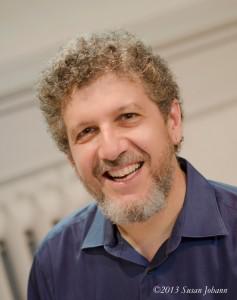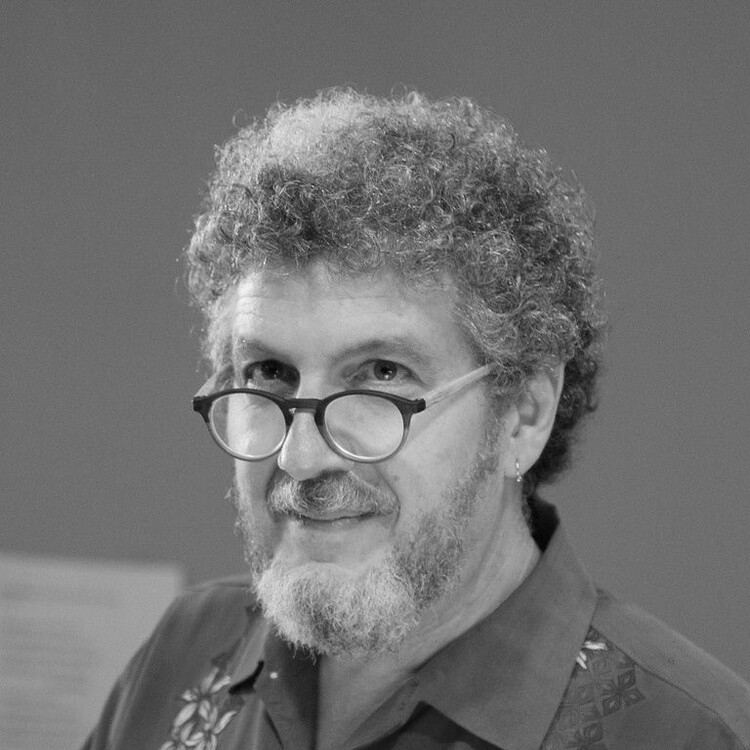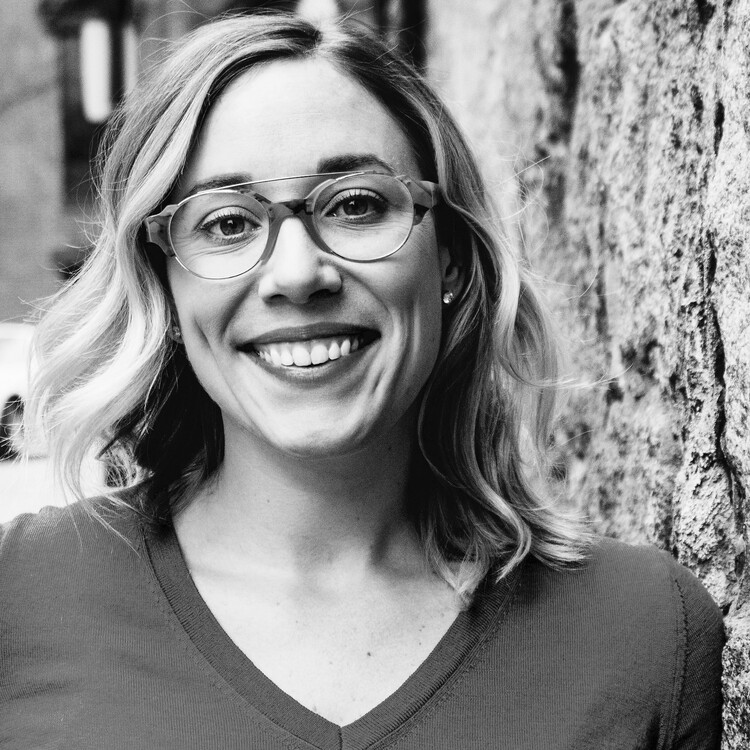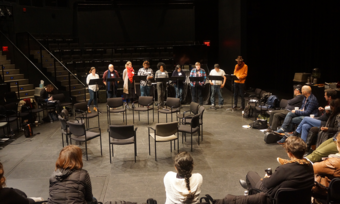A Short Personal History of a Beautiful, Slippery Phrase
Keynote address delivered by Todd London at the Mellon Playwright Residency Convening, September 7, 2014
The Mellon Playwright Residency launched eighteen months ago by pairing fourteen playwrights as salaried staff members in residence for three years at fourteen theatres in eleven cities. The inaugural Residency cohort is here.

I've been thinking about history a lot lately. Maybe it's an inevitable part of the aging process, as you watch huge spans of time collapse and seem smaller and smaller in relation to your own increased number of years. For example, the nonprofit theatres you are all part of, which once seemed to me so eternal, I now realize are all, with the exception of Oregon Shakespeare Festival and, depending on how you date it, Dallas Theatre Center—they are all younger than I am. And that is really young. I feel myself to be very much in-process, very much uncertain. If I forgive myself for being unknowing and awkward and occasionally foolish, I must forgive theatre companies for the same. In other words, when I think about the shared history of this nonprofit art theatre village we live in, I remember that it, too, is a recent experiment, and your residencies are an experiment within that experiment.
Your experiment—these three-year residencies—is part of a fix—a fix made necessary by the unintended consequences of good intentions. Our young theatres, brave and optimistic, cultivated a playwriting profession of greater range, depth, diversity, and imagination than any to have existed previously in this country. Then unintentionally, unwittingly, the same theatres oversaw the near impoverishment and almost-total alienation of that same group of professional playwrights, alienation from the very theatres that had made them possible. In other words, we are here because the nonprofit theatre boom—its new play energies and the attendant spread of professional training programs—made possible a glorious mess of playwrights with which it had no idea what to do.
When Theatre Development Fund published Outrageous Fortune, the result of years investigating new play production and the lives and livelihoods of playwrights, I felt I'd helped author a prosaic Greek tragedy, in which the characters bring about the exact fate they'd acted to avoid, such as the banishment or death of their own children. This is a pretty negative assessment. Some of you will disagree with it. I have research on my side, however, as well as the pride of knowing this very residency program is designed, in some measure, to right those inadvertent wrongs. Now maybe, instead of playing out a lesser tragedy, you find yourselves living in a screwball comedy—like Bringing Up Baby or You Can't Take It With You, like The Cocoanuts—in which madcap playwrights run rampant through a house built on a foundation of propriety and order.
In other words, we are here because the nonprofit theatre boom—its new play energies and the attendant spread of professional training programs—made possible a glorious mess of playwrights with which it had no idea what to do.
I hope you noticed that before I went all extremist and melodramatic, comparing theatres to ill-fated Greeks, I made a wildly upbeat statement: “the theatres you are all part of…” For some of us, being a part of a theatre is nothing new. For playwrights, though, I think we can agree, it's fresh terrain. And there are fourteen of you, at the same time—actual, compensated, officed, insured, budgeted, and titled playwrights, with a three-year guarantee and hopes of more to come—near-strangers in what should have been your land all along. And there are fourteen others of you, leaders of theatres of different stripes, dedicated to the proposition that, although the nonprofit theatre made possible this generation of playwrights, it's this generation of writers that makes possible the future of the nonprofit theatre. Fourteen artistic leaders chosen for this project, because you have proven that dedication over the years in actions as well as words.
I had a personal hit of how unusual the playwrights' situation is last month when my wife, the playwright Karen Hartman, and I arrived at our new workplace, the University of Washington School of Drama. Karen is a senior artist-in-residence here, and though she's been teaching in great universities and privately for nearly twenty years, and though she arrived to find a lovely office with gorgeous leaded glass windows, empty shelving for her books, and a new Mac laptop ordered to her specifications, the thing that really wowed her—that became her iPad desktop photo—was the plaque with her name on the door—a playwright's name on an office door after years of making a professional life from a converted walk-in closet at home. I, on the other hand, like the artistic directors in the HowlRound room, am used to having an office with my name on the door.
I hope all fourteen of you playwrights have actual nameplates. If you don't, ask your theatre to order one for the rest of your residency. If they can't afford it, tell them you know a funder who might help.
All this is preamble. I've been asked to howl for around half an hour about creating an artistic home, something I've been thinking about for a long time and something I can't pretend to know how anyone else should do, especially because each of your situations is so different, each of your expectations and hopes are so particular, because the pacts you've made—theatre and playwright—are so various. Moreover, the very notion of a home for an artist or group of artists is a slippery thing, and the ground keeps getting slipperier. Again, I've been thinking about history as a way of understanding where we find ourselves now. What has changed, and how might we engage and lead responses to that change?
So here's what I've got. I call it, “A Short Personal History of a Beautiful, Slippery Phrase.”
It's got an epigraph, from Anne Bogart's new book of essays, What's the Story. This is it:
What distinguishes the theatre from all other art forms is that the theatre is the only art form that is always about social systems. Every play asks: Can we get along? Can we get along as a society? Can we get along in this room? How might we get along better?
I don't know the origins of the phrase “artistic home,” but I have tracked it since the mid-80s. The expression came to life for me as the object of a gerund. A gerund, you probably don't remember, is the “ing” form of a verb, as in “creating an artistic home” or “thinking about playwright residencies.” I was groping for a title to a report on the institutional theatre and considering a number of verbs in gerund form: “renovating” the artistic home, “remaking” it, “rebuilding.” Like that. You’ll notice that each of these verbs assume that such an artistic home once existed, that it only had to be rediscovered, reinvented, or refurbished. Even the article “the” suggested a concrete, pre-existing form. More, it suggested an agreement—that there was such a thing as an artistic home, that we knew what it had been, that it had a design or a structure or a skeleton and that with enough integrity and good will it could be re-created, revitalized.
That was in 1986 and '87, a very different moment from our moment today. It was different, because when artistic directors spoke of “a theatre,” nine out of ten of them meant the same thing: that is, a company with a building in a city with, usually, a two-headed leadership structure, and a meddlesome but possibly generous board of directors. They meant an organization in which a resident acting company was no longer possible and whose artistic vision flowed essentially from a principal artist, usually a director. Occasionally, in the year of national discussions that led to this report, there was talk of resident playwrights, but mostly that talk came from playwrights themselves, people like Richard Nelson, who shocked some of us by saying that in all the American theatres he’d ever worked, he’d never even had a desk to write at, let alone, I suspect, a plaque with his name on it.
It was a different time because the discussions that led to the book, The Artistic Home, grew out of a criticism leveled by the head of the NEA that there was an “artistic deficit” in the American theatre, that the institutional tail was wagging the artistic dog. And it was a different time because we had an NEA and few enough theatres of note that there was still a vague hope of something approaching a subsidized theatre. And maybe most of all, it was a different time because the theatres, at least those who gathered around the Theatre Communications Group tables during the yearlong conversations that led to the report, looked so much alike, not just in structure and intention, but also in complexion.
That was then. Now the question of how to reinvigorate the art of an institution is only one of many. Some of our fellow travelers have written off the institutions altogether; they’ve gone their separate ways, toward looser structures, smaller organizations, tighter ensembles, and more targeted missions. One of the debates that rages under this residency program is whether a foundation with playwrights on its mind should support large institutional theatres at all, especially if those theatres haven't previously shown a will to provide living wages, let alone deep hospitality, to playwrights. The other side argues that it's the institutions that have the capacity to make these residencies stick, to provide salaries and benefits for writers, even after Mellon goes away. Mellon, in its infinite wisdom, chose to have it both ways—rewarding will and capacity, searching out large companies with the strongest track records of support, and smaller ones, willing to grow enough to take playwrights in for the long haul.
Still, the institutional question pales beside the real question that drives our discussions nearly three decades later: Whose home is it? Thirty years ago this question was bubbling beneath the surface, but it hadn't broken through. It didn’t yet dominate what we feebly refer to as field conversations. And with the question of whose home is it come so many other questions: Who gets to decide? Who gets left out? Who sees herself on the stages of this so-called home? What is a stage? Can we ever be fully inclusive? Can we ever make home together or must our companies part company? Who do we serve? It is these questions that have led so many of the playwrights in the room to take leading roles in their theatres' community engagement efforts. It is these questions that have forced theatre administrators to look to playwrights and other individual artists to diversify their racially and economically homogeneous institutions.
A lot happened to raise these questions, and playwright residencies are one attempt to answer them. The so-called culture wars happened, and a censuring Congress became a censoring one. As a direct result, funding for individual artists—notably playwrights—stopped and, for most of twenty years, stayed stopped. A lot more history conspired to bring you here. Our theatres multiplied like gremlins hitting water. Our core audiences began to age and drift and die away. Funders, picking up the slack the government dropped, turned limited resources toward social imperatives other than art and, so, came to expect more than the mere mounting of shows.
You are here, too, because the millennial shit hit the technologically supercharged fan and everything that previously seemed knowable, institutionally containable, suddenly broke into a bajillion bits. And you are here because for decades leading artists were working under the institutional radar, in places we loosely called “communities" or among “underserved populations,” demonstrating another function of art, also known as “social justice.” And you are here because theatre administrators can't build these bridges as well as artists can. Finally, you are here because, in recent history, our steadfast Western belief in the power of individual voice has been called into question. Everybody gets into the act. Everybody “writes” the play. Only you, shapers of words and makers of theatres, can best test this proposition.
So here we are. Fourteen playwrights and fourteen theatres—particular and various—trying to figure out how to make home. I want to suggest that, after all this fast, furious history, the task has grown bigger than that. The true experiment now is how to make a society.
Remember my Anne Bogart quote?
What distinguishes the theatre from all other art forms is that the theatre is the only art form that is always about social systems. Every play asks: Can we get along? Can we get along as a society? Can we get along in this room? How might we get along better?
Anne is talking here about plays, but later in the essay “Politics” she goes on to write about productions: “No matter how dysfunctional the characters in the play, the community of actors who perform the play must operate at the height of their abilities. … The community of artists proposes, within the fabric of every production, nothing less than a model society. This is their message.”
“A model society.” This, I suggest, is your message too. We, the witnesses and beneficiaries of your experiment within an experiment, are waiting to hear it. It may be the new definition of an artistic home. Moreover, just as the rehearsal process reveals itself in production, so the process we engage to make society is always reflected in the society we make. We are what we do, and we are how we do it. I deeply believe this. If you treat collaborators as employees, you will make hierarchical work within a stratified system. If you treat co-workers as true partners, you will, in ways implicit and explicit, model democracy. If you think a door with a name on it doesn't require you to show up and take responsibility for the success of the theatre, you are squandering a gift that is the work of many people and many years. If you work with your fullest self, take your place at the table, whatever the organizational chart suggests, you model leadership. And if you engage with others out of a spirit of kindness, respect, and the awareness that the answer is always in someone unexpected, you will make a society that transmits cooperation, generosity, and connection, even love.
This is where my personal history of the phrase has taken me, to an abiding sense that our theatrical experiments are actually social ones. That while we make work, we are always making world.
If you work with your fullest self, take your place at the table, whatever the organizational chart suggests, you model leadership.
And of course, as artists or sustainers of the arts, we want that world—our home—to be more artistic. I did when I sat in rooms as a young director recording the words of artistic directors, feeling they were often more invested in selling their theatres to each other than honestly sharing their struggles. I did during the eighteen years I was trying to make an inspiring, communitarian lab for writers at New Dramatists, a space for process and inquiry amid demands for product and results. I do now as I seek bridges between training and scholarship and profession, root and branch, across disciplines and fields of study. I want to live in the creative thrill I felt when a roomful of New Dramatists read to each other. I want to live in the big obsessive impossible ideas to which the artists among us give their lives. I want to celebrate their willingness to chase those ideas, despite the personal cost. And I want to tear the theatre once and for all away from the boardroom and business school and the marketplace, to lodge it back into the arts, alongside painting and sculpture, literature and contemporary dance, music, both classical and new. This is how I think of “artistic.”
“Home” is a different matter. Home is a place of freedom and tether, self-determination and connection. Home is a place you define for yourself, maybe the only place you can “own.” If you don't feel ownership, it isn't home. Maybe that should be the test of a residency: does the playwright truly feel she owns this theatre home? Or is the playwright always a guest here, awaiting invitation to have a say, play a part, sit at the table.
In the end, though, it's hard to describe a home from inside without reference to those outside. And that's tricky because we can't see the people who aren't in the room. We can know what we take for granted about the comforts of our own homes.
This lack of surety has led me to a final supposition. My thought is this: When we talk about an artistic home in 2014, we are no longer simply talking about how to welcome artists more fully into established theatres. We are talking about many other things that dominate our national debates. When we talk about artistic home we are talking about distribution of wealth. We are talking about an economic system that has reduced our human relations to corporate and consumer relations. We are talking about a history of exclusion and bias and, even, a history of domination, enslavement, and genocide. In other words, in a discussion that should be simple, should be structural—how do we create better environments for artists (in this case playwrights)—we are grappling with bigger, more problematic, global and even horrific things. These things have divided classes and races and genders of people in this culture, as institutional life has grown and capitalism has advanced. You can't unearth the uses of power and domination in human history and close your eyes to them in the present, even in our own relations.
And while we can't solve these global problems by creating a few gemütlich salaried positions for playwrights, we ignore this context at our own peril. Artist relations are connected to pay scale in theatres. Artist relations and the role of these artists in communities must be addressed as a way of countering our reduction of collaborators to employees and audiences to consumers. Diversity and inclusion are inseparable from what happens in a room between two people, between playwright and artistic director, between you and me. We all ride history and we carry it.
Anne Bogart reminds us, “The community of artists proposes, within the fabric of every production, nothing less than a model society. This is their message.”
The daily act of trying to reincorporate generative artists—or artists at all, other than that one artistic director—into the ongoing life of a theatre is part of another, bigger, knottier ongoing project: of exploring freedom and creating democracy. Writers, in their wonderful and willful refusal to ignore the call of their own hearts, show us our capacity for freedom. Theatres, in their determination to sustain intimacy and live-ness in a social context, demonstrate our will to make better society.
This is what we stand to lose when our artists and theatres separate themselves from each other. This is what you stand to show by bringing them back together.
The Mellon residencies are an experiment, and you are guinea pigs and lab rats. You are also pioneers in the middle of it all, halfway through whatever this residency thing is or is not or may be or hopefully will in retrospect have been. The difficulty about being at the forefront of such an experiment within an experiment is that, while others will learn from your mistakes or struggles, you have to suffer through them. The great thing about it is that you get to share the successes and joys.
We are watching you, jealously, hopefully.











Comments
The article is just the start of the conversation—we want to know what you think about this subject, too! HowlRound is a space for knowledge-sharing, and we welcome spirited, thoughtful, and on-topic dialogue. Find our full comments policy here
thanks for so much to chew on... we are all in the conversation in academia as well, where - as you note- we are training more working artists than there are jobs for.. the institutions of HOME complicates it all. "Home is where the ART is" must be translated in to another paradigm. I await your creative re-interpretation of this idea.
Thank you to HowlRound and Mr London for putting this in context of the whole.
"When we talk about an artistic home in 2014... we're talking about many other things that dominate our national debates... distribution of wealth... an economic system that has reduced our human relations..."
This is the part of the essay that most resonated with me. For I've long advocated that we theater folk should be less navel-gazing regarding our own dire circumstances (which causes us to think we can solve the problem simply by demanding more subsidy from taxpayers), but instead realize that the economic problems we face are mostly due to how far downhill the country has gone since the early sixties -- largely due to the Vietnam war and all the many (equally counter-productive) wars that have followed.
This is especially vital now that Obama is repeatedly trying to get us to ignore the mistakes of the past and get involved in another three-year mission in the middle east against ISIS. (Whose weapons primarily come from the U.S., between those the cowardly Iraq army abandoned and those the Syrian rebels took with them when they joined ISIS.)
Throughout history nations have been destroyed by the desire of those in power to have far-flung empires that they can lord over. If another war-monger (regardless of gender or party affiliation) wins in 2016, the lack of an artistic home will likely soon be the least of our problems.